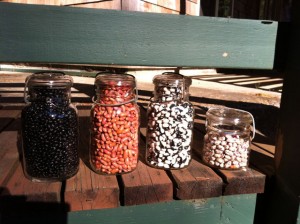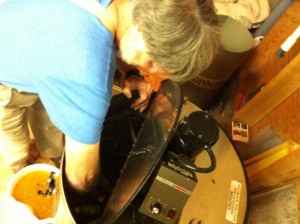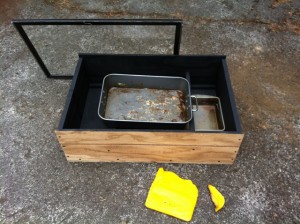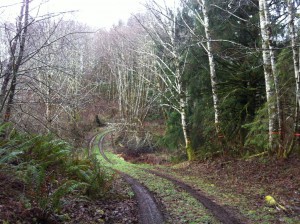 Now that we’ve “bought the farm,” it’s time to see what we’ve signed up for. There is a pretty big list of fixit items, including things like thinning downed timber and re-gravelling the driveway. That’s actually a bigger deal than you might think, as the driveway is just over a thousand feet long. But it must be done; the upper half of it is impassable without four wheel drive, and last week Josh got stuck in the lower half and I had to pull him out with my trusty truck and tow rope.
Now that we’ve “bought the farm,” it’s time to see what we’ve signed up for. There is a pretty big list of fixit items, including things like thinning downed timber and re-gravelling the driveway. That’s actually a bigger deal than you might think, as the driveway is just over a thousand feet long. But it must be done; the upper half of it is impassable without four wheel drive, and last week Josh got stuck in the lower half and I had to pull him out with my trusty truck and tow rope.
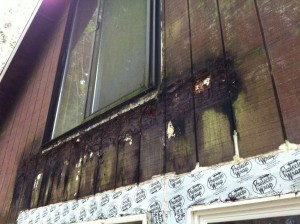 The big item, though, is the cabin. I’ve finally had a chance to tear into it and see what I’m dealing with, and it’s about as bad as I suspected after my preliminary survey. The siding is rotten and will have to be replaced, and as you can see here, it’s straight through the wall in some places. This is unfortunate, because on the south side where the weather hits it, the siding was impropoerly installed and a LOT of water penetrated. On the inside, I removed the existing fake wood flooring, and discovered that it was bubbled up because the water from the wall leak had made its way through to the subfloor, which was crappy particleboard. It had turned into a wet, moldy dishrag, sagging between the joists. End result: total tear-out of the floor, down to joists. Luckily, only a few of the joists have any water damage, and replacing them before I install the new subfloor will not be too hard.
The big item, though, is the cabin. I’ve finally had a chance to tear into it and see what I’m dealing with, and it’s about as bad as I suspected after my preliminary survey. The siding is rotten and will have to be replaced, and as you can see here, it’s straight through the wall in some places. This is unfortunate, because on the south side where the weather hits it, the siding was impropoerly installed and a LOT of water penetrated. On the inside, I removed the existing fake wood flooring, and discovered that it was bubbled up because the water from the wall leak had made its way through to the subfloor, which was crappy particleboard. It had turned into a wet, moldy dishrag, sagging between the joists. End result: total tear-out of the floor, down to joists. Luckily, only a few of the joists have any water damage, and replacing them before I install the new subfloor will not be too hard.
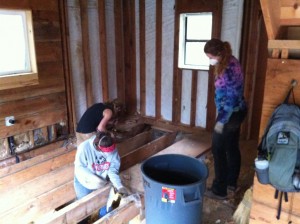
Did I mention that the rotten existing subfloor is between the wall and the foundation? That means I will have to bolt a header onto the existing wall, knock holes in the wall (that will be easy, as rotten as it is) to pass needle beams through, and temporarily jack the entire building up an inch or two so I can remove the old and install the new. Thank goodness the building is only 640 square feet.
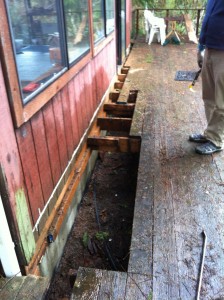 The deck is very cool with a great view, but it also has to go away. Besides the fact that it’s rotting from neglect, whoever installed it chose to hang it from a ledger on the building, without flashing it. This is one of the #1 bad details perpetrated by unknowing remodelers, and virtually guarantees that you will get water (and subsequent rot) in your home. But don’t worry, the deck will reappear anew before it’s all over, and it will be even better than before. I promise.
The deck is very cool with a great view, but it also has to go away. Besides the fact that it’s rotting from neglect, whoever installed it chose to hang it from a ledger on the building, without flashing it. This is one of the #1 bad details perpetrated by unknowing remodelers, and virtually guarantees that you will get water (and subsequent rot) in your home. But don’t worry, the deck will reappear anew before it’s all over, and it will be even better than before. I promise.
Now you notice I used the word “I” in most of those previous paragraphs. That’s oversimplifying; the reality is that all of our friends here are both excited about our new property and willing and able to pitch in and help. This makes us really happy, not just for the free labor, but for the camaraderie and community aspect of the project. Since the beginning of the Peace Crops farm, we’ve wanted it to be a way to build community. It’s a way to make your friends a permanent part of your home, without creepy things like burying them in the foundation.
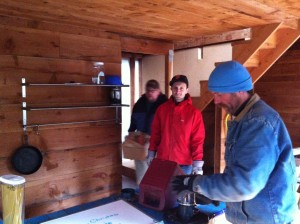 It’s probably not a coincidence that many of the first friends to help us are former Peace Corps volunteers (notice the spelling!). Here’s Dan, a great friend who worked in a site very near ours in Guatemala; and Josh, who served in Bolivia, removing the kitchen counters. In the background is Ryan, who I’ve been friends with for much of my life and whose family owns the land we farmed on the last two years. He’s been very helpful with both advice and labor, and I will rely on him quite a bit in the coming months. In fact, one of the biggest challenges on this job will not be getting the manpower, but being able to manage it in a way that people are kept busy so they don’t get bored, yet get enough rest so they have fun and still want to come over for dinner after it’s all done.
It’s probably not a coincidence that many of the first friends to help us are former Peace Corps volunteers (notice the spelling!). Here’s Dan, a great friend who worked in a site very near ours in Guatemala; and Josh, who served in Bolivia, removing the kitchen counters. In the background is Ryan, who I’ve been friends with for much of my life and whose family owns the land we farmed on the last two years. He’s been very helpful with both advice and labor, and I will rely on him quite a bit in the coming months. In fact, one of the biggest challenges on this job will not be getting the manpower, but being able to manage it in a way that people are kept busy so they don’t get bored, yet get enough rest so they have fun and still want to come over for dinner after it’s all done.
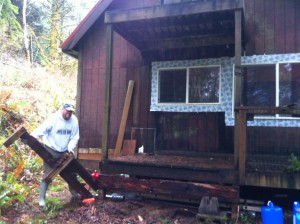 If this all sounds like a lot of work and makes me seem like a macho building guy, please know that it’s not the case and that I’m in “fix the problem” mode, purposefully not thinking too hard about the monumentality of the entire task so as to not freak myself out. My brother is a PhD engineer working as a spook for the government, a very smart guy, and I remember a good piece of wisdom he once shared with me: there is no engineering problem so complex that you can’t solve it by breaking it down into smaller, manageable parts. Poco a poco, hombre. Poco a poco.
If this all sounds like a lot of work and makes me seem like a macho building guy, please know that it’s not the case and that I’m in “fix the problem” mode, purposefully not thinking too hard about the monumentality of the entire task so as to not freak myself out. My brother is a PhD engineer working as a spook for the government, a very smart guy, and I remember a good piece of wisdom he once shared with me: there is no engineering problem so complex that you can’t solve it by breaking it down into smaller, manageable parts. Poco a poco, hombre. Poco a poco.

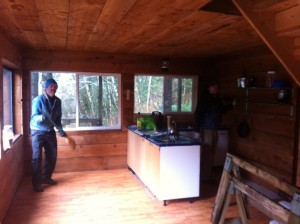
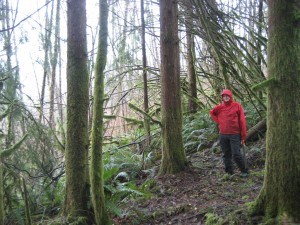
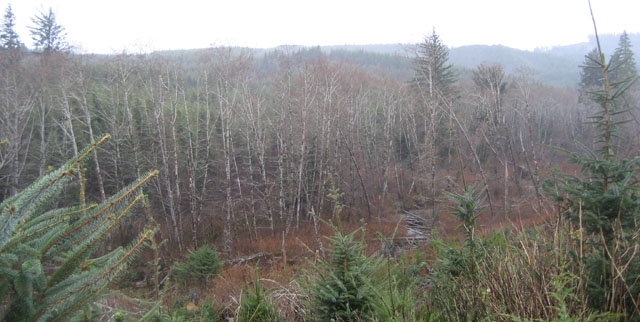
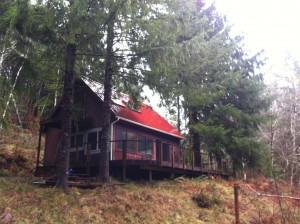
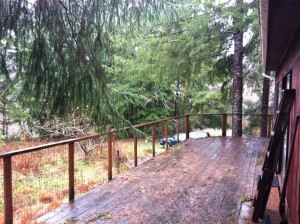
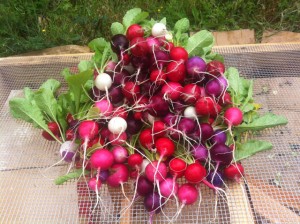
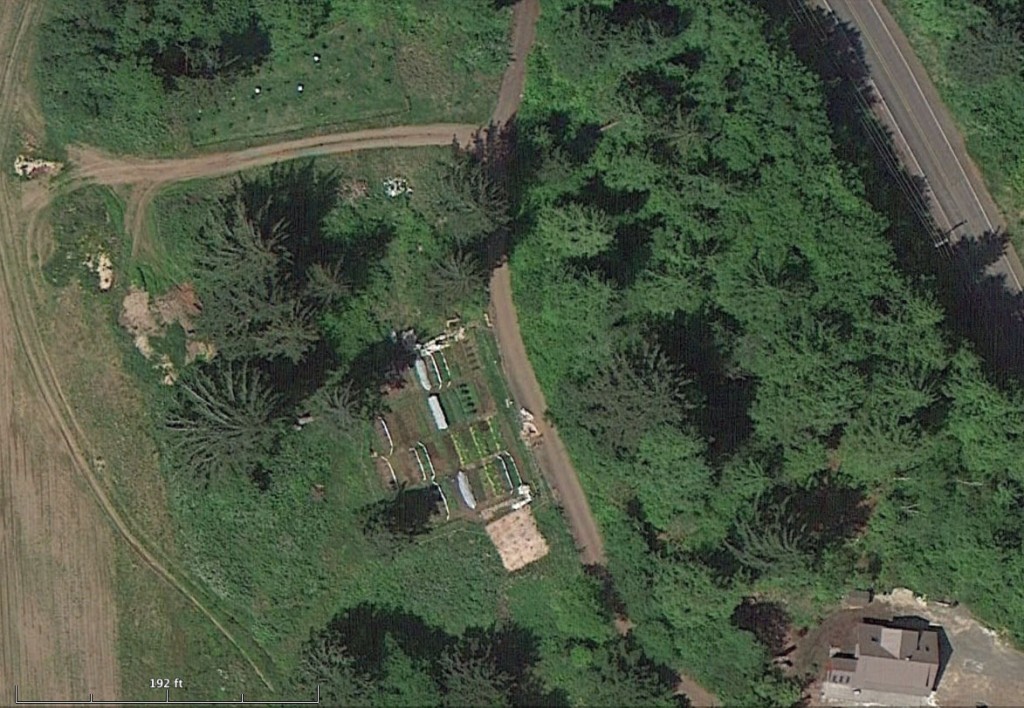

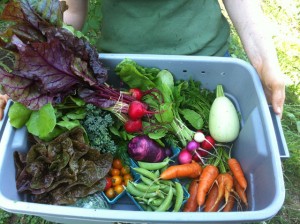
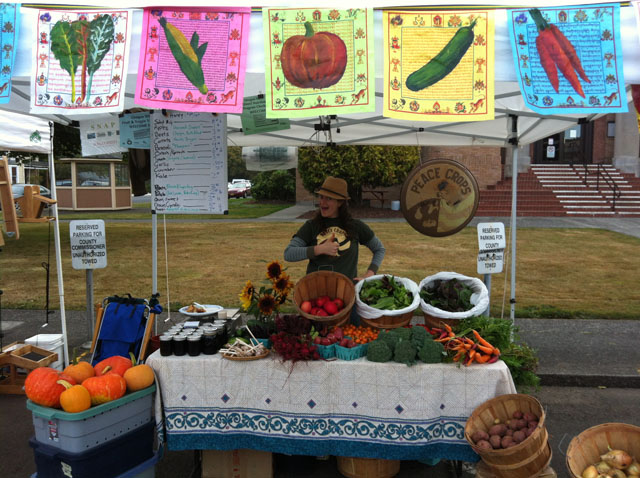 The end of the farming season has arrived. Or, more precisely, the end of the farmers’ market season. Here’s a picture of Emily at our stand in Tillamook. At both the Manzanita and Tillamook farmers’ markets, we had somewhat slow final weeks… most of the tourists are gone, and the locals can’t entirely make up the difference. One thing that helped keep revenues up was the honey; nearly a third of gross sales has been honey in the last three weeks. It makes me even more excited about beekeeping than before, if that were possible, and we’re planning on expanding to 6 or 7 hives next spring.
The end of the farming season has arrived. Or, more precisely, the end of the farmers’ market season. Here’s a picture of Emily at our stand in Tillamook. At both the Manzanita and Tillamook farmers’ markets, we had somewhat slow final weeks… most of the tourists are gone, and the locals can’t entirely make up the difference. One thing that helped keep revenues up was the honey; nearly a third of gross sales has been honey in the last three weeks. It makes me even more excited about beekeeping than before, if that were possible, and we’re planning on expanding to 6 or 7 hives next spring.
